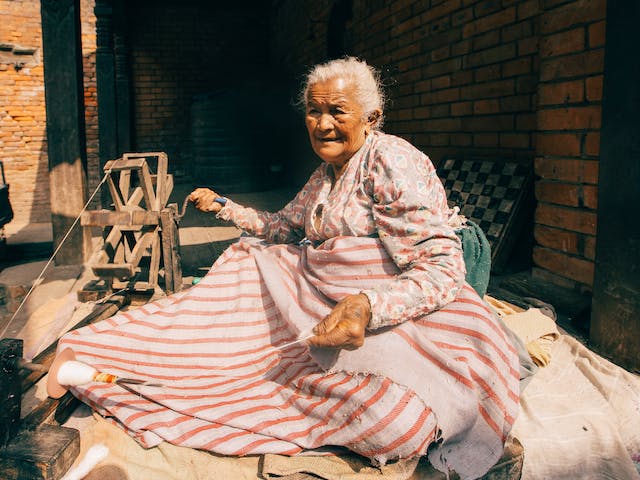
What is a spinning jenny? It is a machine that can spin cotton into multiple reels of thread at the same time. It revolutionized the textile industry and is one of the key machines of the Industrial Revolution.
There is a story that the inventor, James Hargreaves, named the spinning jenny after his wife Jenny, or his daughter Jenny, but church records show that his wife was called Elizabeth and he had 11 children, none of whom were called Jenny. It is far more likely that “jenny” was an old word for “engine”.
Before the spinning jenny was invented, making cotton for clothes was a long and laborious process. Cotton was imported into the UK from plantations in America and in India. The cotton was then spun by hand. The cotton had to be cleaned and brushed to make the fibers straight. Then it was pulled into yarn on a spinning wheel before being sent to the weaver to make cloth. The cotton fibers are pulled over the large wheel, which twists them together before they are wrapped around a spindle that was horizontally fixed to the frame, making reels of yarn. Spinning was a slow process and a weaver could use in a day what it took a spinner a week to make. Most cotton spinners worked at home.
By the mid-18th century, the agricultural revolution had led to a rising population and a rising middle class. More people had more money and the demand for cotton clothes grew so rapidly that the cotton spinners could not keep up. The weaving industry had upped its game and in 1733 John Kay had invented the flying shuttle which allowed weavers to weave much more quickly. This was the situation that James Hargreaves found himself in.
James Hargreaves was born in 1720 in England. He was a carpenter and a weaver. He invented the spinning jenny in 1764 and his idea is said to have come about because of an accident. Someone knocked over a spinning wheel in front of him and he noticed that the wheel and the spindle both continued to turn. It had been assumed that the spindle needed to be horizontal for spinning to happen and this realization showed James Hargreaves that he could put multiple spindles vertically on the frame and spin more cotton at the same time.
He went to his workshop and altered the common spinning wheel. He widened the wheel so it could take more yarn at the same time. Then he added eight spindles vertically above the wheel for the yarn to be wound around. The spinner turned a wheel that turned a series of cogs and made the spindles rotate, winding the yarn. One person could now spin as much yarn as eight people.
There were a lot of arguments to say that this new invention would do away with jobs, but there was such a great need for cotton that the same number of spinners would still be needed, they would just be making eight times more cotton. The spinning jenny reduced labor costs, which made cotton and cotton garments cheaper, which grew demand for cotton. It was a circle that pushed the growth of the cotton industry. There was still a need for spinners, but, what it did do was move spinners out of their houses and into factories. It was also an easy machine to use, so the need for skilled spinners vanished and the need for simple machine operators grew.
The advances that came on the back of the spinning jenny probably revolutionized industry more than the spinning jenny did itself, but without the start point of the spinning jenny, there would have been no advances, so it was a huge step.
Following the invention of the spinning jenny, a water version was invented. This was a similar concept, but it used water power to turn the wheel, thereby allowing one worker to control multiple machines. This reduced the necessary workforce. Then, steam power was introduced, allowing the machines to work faster and for fewer people to control even more machines. This was coupled with power looms that could weave the material faster and in larger quantities. All of these machines worked better if they were connected, and this created the need for large factories and a workforce to staff them. Spinning and weaving jobs disappeared, but maintaining the machines and running the factories jobs appeared. Children were famously used to go into the moving machines and pick out yarn that was jamming them. A highly dangerous profession. The new factories needed a workforce and the factory owners often built towns around them to hold the workers. It is often said that cotton was the driving force behind the industrial revolution. And this is what I learned today.
Photo by Mehmet Turgut Kirkgoz : https://www.pexels.com/photo/elderly-woman-using-a-spinning-wheel-11428921/
Sources
https://www.cotton.org/pubs/cottoncounts/story/spun-and-woven.cfm
https://science.howstuffworks.com/innovation/inventions/spinning-jenny.htm
https://en.wikipedia.org/wiki/Spinning_jenny
https://en.wikipedia.org/wiki/James_Hargreaves
https://www.thoughtco.com/textiles-during-the-industrial-revolution-1221644
https://en.wikipedia.org/wiki/Textile_manufacture_during_the_British_Industrial_Revolution

[…] machine that knitted stockings. It was one of the first machines in the industrialization of the textile industry and it could be operated by untrained people. In the 1700s, it was adapted to make lace, […]